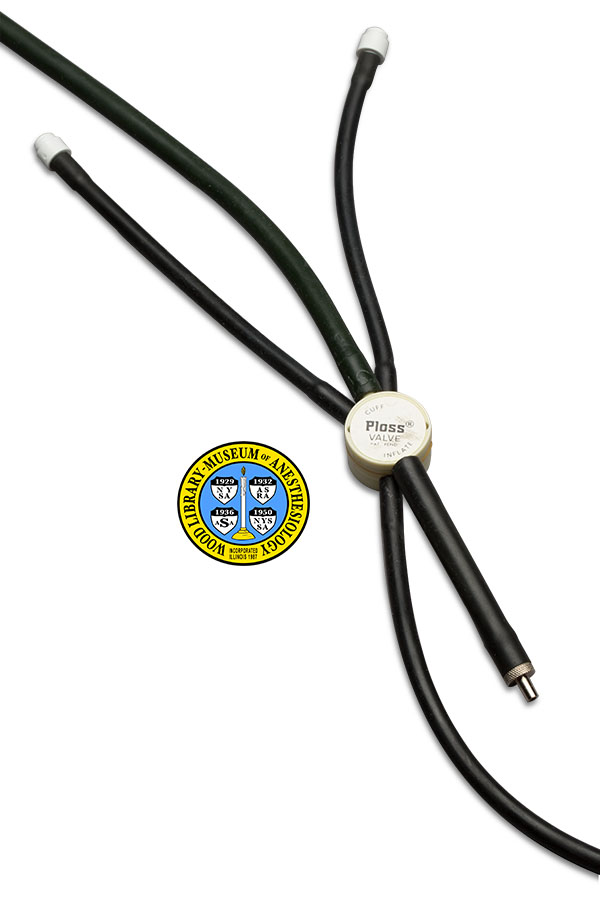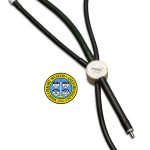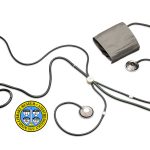Ploss Valve
Anesthesiologists are responsible for monitoring the patient's vital signs during surgery. Twin brothers Robert Earl Ploss, M.D. (1922-2015) and William Roger Ploss, M.D. (b. 1922) were both anesthesiologists and inventors. In 1955, they introduced a device that could simultaneously monitor the patient's blood pressure, pulse, and respiration. It consisted of earpieces and two diaphragms, together with tubes and connectors that could attach these to any ordinary blood pressure cuff. The tubes were long enough to enable the anesthesiologist to use the device while seated at the head of the operating table.
One of the diaphragms would be fixed to the patient's chest with an adhesive pad. The other would be placed under the blood pressure cuff. The central part of the device is a three-way valve (also called a switch valve) in which all of the tubes converge. When the blood pressure cuff was inflated, the switch closed the acoustic pickup from the chestpiece. Shown here is an example of the second model, introduced in 1968. It was made by 3M and sold under the trademarked name "Ploss Monitorscope". By the 1980s, it had been made obsolete by an increasing number of electronic monitors of patient vital signs.
Catalog Record: Ploss Valve Ploss Valve
Access Key: aqlc
Accession No.: 2000-08-17-2 A
Title: Ploss Monitorscope / [designed by Robert E. Ploss and William R. Ploss].
Author: Ploss, Robert E. (Earl), 1922-2015.
Author: Ploss, William R. (Roger), b. 1922.
Corporate Author: 3M Company.
Title variation: Alt Title
Title: Ploss acoustic switch.
Title variation: Alt Title
Title: Ploss stethoscopic monitoring system.
Title variation: Alt Title
Title: Ploss stethoscope.
Title variation: Alt Title
Title: Ploss valve.
Title variation: Alt Title
Title: Switching valve.
Publisher: St. Paul, Minnesota : 3M Company, [ca. 1955-1965]
Physical Description: 1 monitor : plastics, rubber, metals ; 155 x 155 x 2 cm.
Subject: Blood Pressure Monitors.
Subject: Patient monitoring.
Subject: Stethoscopes.
Note Type: General
Notes: Title taken from original container.
The first year in the date range is based on the date of that the previous model was described. It is likely that the object was manufactured some years later. Because the cataloged object is marked patent pending, the second year in the date range is based on date that the patent was granted.
Described from the perspective of the user. The front is considered that side closest to the user. On that side, the valve has two ports.
Note Type: General
Notes: The cataloged object has only one of the two original diaphragms. For purposes of photography, the cataloged object was married to a second diaphragm, Accession # 1994-04-11-1 AA, as well as to a Tycos blood pressure cuff and inflation bulb from the parts collection.
Note Type: With
Notes: Original cardboard box measures approximately 5 x 51.5 x 13.5 centimeters. A label on the top panel of the lid of the box reads: “Ploss (TM) [new line] BRAND [new line] MONITORSCOPE [new line] NO. 2185 [new line] AN ACOUTIC SYSTEM FOR CONSTANT MONITORING OF BLOOD PRESSURE, PULSE AND RESPIRATION [new line] 3M COMPANY”. Handwritten notes on this panel, in various inks, read: “Simmons Rg. 9443 [new line] 3-81 meth”; “Dr. Miller” (crossed out), and “Prentice”. The right-hand side panel of the lid is split. A label on this panel reads: “Ploss TM BRAND [new line] MONITORSCOPE [new line] NO. 2185 [new line] Medical Products Division 3M COMPANY [new line] ST. PAUL, MINNESOTA 55101”. A handwritten note on the back panel of the lid reads: “Dr. Prentice”.
The box contains additional, related parts, including “3M Double-stick pads for stethoscope and electrode attachment”, a transparent plastic tube with a plastic connector at each end, a white plastic cover for the diaphragm, a pair of white plastic earpieces, an elastic band, and various plastic and metal connectors.
Note Type: Citation
Notes: American Society of Anesthesiologists Archives, Membership Series. Archives. Located at the Wood Library-Museum of Anesthesiology, Schaumburg, Illinois.
Note Type: Citation
Notes: Barker SJ. Too much technology? Anest Analg. October, 2003;97(4):938-939.
Note Type: Citation
Notes: Martin JT. Neuroanesthetic adjuncts for surgery in the sitting position, I. introduction of basic equipment. Anesth Analg. July-August, 1970;49(4):577-587.
Note Type: Citation
Notes: Peterson LJ. Monitoring equipment. Anesthesia Progress. September-October, 1977;24(5):155.
Note Type: Citation
Notes: Ploss RE. A simple constant monitoring system. Anesthesiology. May, 1955;16)3):466-467.
Note Type: Citation
Notes: Ploss WR. An acoustic switch for use in constant monitoring. Anesthesiology. September-October, 1968;29(5):1052-1054.
Note Type: Citation
Notes: Ploss WR, Ploss RE. Letter to the editor of clinical workshop: A practical stethoscope approximator. Anesthesiology. March, 1969;30(3):334.
Note Type: Citation
Notes: Ploss WR, inventor. Constant stethoscopic monitoring system. US patent 3,517,665. June 30, 1970.
Note Type: Citation
Notes: Ploss WR, inventor. Valve for stethoscopic monitoring. US patent 3,693,611. September 26, 1972.
Note Type: Citation
Notes: Trieger N, Erlichman M, Barkin M, Goldsmith D, Schiffman L, Levin D, Sturman I. Anesthesia monitoring of the ambulatory patient. Anesthesia Progress. May-June, 1976;23(3):81.
Note Type: Citation
Notes: United States Government Publishing Office website. Electronic Code of Federal Regulations, Title 21-Food and Drugs, Part 868-Anesthesia Devices, Subpart B-Diagnostic Devices. https://www.ecfr.gov/cgi-bin/text-idxSID=500e130a92b3979cc1c195b71449b7aa&mc=true&node=pt21.8.868&rgn=div5#se21.8.868_11965. Accessed September 20, 2017.
Note Type: Physical Description
Notes: One multiple-function monitor; Consists of a cylindrical valve with five openings or ports in its circumference, five rubber tubes, and one stethoscope diaphragm; The width and depth given in the short description represent the object with the tubes fully extended; With the addition of a second diaphragm (lacking in this set), the width and depth would become approximately 161 centimeters;
The valve is made of two, white plastic cylinders that are held together by adhesive; A label on the top half of the valve reads: “Heart, BP, Ear [new line] 3M Company; A label on the bottom half of the valve reads: “Cuff, Inflate” [new line] Ploss [new line] VALVE [new line] Pat. Pend.”; The valve has two ports for connecting tubes on that side closest to the user; One of these two ports is situated in the top half, and holds a tube that can be connected to the pump of a blood pressure cuff; The second port is situated in the bottom half and can be connected to stethoscope earpieces; The valve has three ports for connecting tubes on that side farther from the user; One of these three ports is situated in the top half, and holds a tube that can be connected to a blood pressure cuff; The other two ports hold tubes that can be connected to stethoscope diaphragms;
The diaphragm measures approximately 1 centimeter in height and 5.5 centimeters in diameter; The upper portion of the diaphragm is made of metal, and is marked “3M”; The lower portion of the diaphragm is made of white plastic.
Note Type: Reproduction
Notes: Photographed by Mr. Steve Donisch, June 19, 2017.
Note Type: Acquisition
Notes: Gift of The Mayo Clinic, Rochester, Minnesota, facilitated by Douglas R. Bacon, M.D.
Note Type: Historical
Notes: Anesthesiologists are responsible for monitoring the patient’s vital signs during surgery. Twin brothers Robert Earl Ploss, M.D. (1922-2015) and William Roger Ploss, M.D. (b. 1922) were both anesthesiologists and inventors. Dr. Robert Ploss was a member of the American Society of Anesthesiologists (ASA) from 1952 through 1974, and pursued his career in California. Dr. William Ploss was a member of the ASA from 1966 through 1977, and pursued his career in Florida.
The device which they co-invented could simultaneously monitor the patient’s blood pressure, pulse, and respiration. In various publications it has been called an acoustic valve, a switch valve, a monitoring system and a stethoscope. It consisted of earpieces and two diaphragms, together with tubing and connectors that could attach these to any ordinary blood pressure cuff. The set did not include a cuff. The tubes were long enough to enable the anesthesiologist to use the device while seated, as usual, at the head of the operating table.
One of the diaphragms would be fixed to the patient’s skin with an adhesive pad. The other would be placed under the blood pressure cuff. The central part of the device is a three-way valve (also called a switch valve) in which all of the tubes converge. The device could be used either as a binaural stethoscope (with two earpieces) or a monaural one (with a single earpiece). Using it as a monaural stethoscope enabled the anesthesiologist to isolate either the sounds of the patient’s heart, or those of the esophagus, or the Korotkoff (blood pressure) sounds.
The first model of the device was introduced by Dr. Robert Ploss in 1955; that model was manufactured by Burdick
Laboratories of Glendale, CA. In 1968, the second, model was introduced by Dr. William Ploss, who filed patent applications for it in 1968 and 1970. These patents were granted in 1970 and 1972, respectively, and both patents were assigned to the 3M Company, of St. Paul, MN. The cataloged object is an example of the second model, made by 3M, and sold under the trademarked name “Ploss Monitorscope”. The Monitorscope set included adhesive pads with which to fix the diaphragm in place, leaving the user with one hand free while he manipulated the cuff with the other.
The Ploss valve appears in the medical literature as late as the 1980s. By then, it had been made obsolete by the increasing availability of electronic patient monitors.
Note Type: Publication
Notes: Siepmann HP. New, simple method of monitoring blood circulation and respiration by the use of a Ploss-monitorscope. Z Prakt Anasth. July, 1971;6(3):206-8.
Note Type: Exhibition
Notes: Selected for the WLM website.



